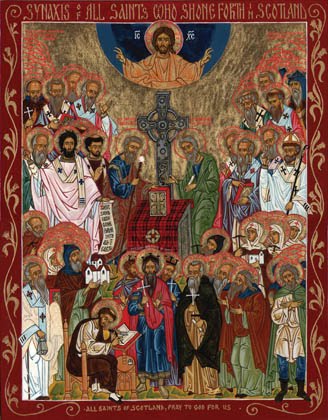by Lee Rimmer
The girl's body was buried in her wooden bed
The remarkably rare discovery of the grave of an of an Anglo-Saxon teenage girl buried on a wooden bed, with this gold and garnet cross on her chest, was widely reported this year(2012) and raises questions about whether her beliefs were Christian or Pagan.
Archaeologists at the Cambridge Archaeological Unit believe the mid-7th Century grave, uncovered at Trumpington Meadows near Cambridge, represents the threshold between Paganism and Christianity in Anglo-Saxon England. They also suggest that the type of burial and the quality of the cross itself could indicate that the girl was from a noble family recently converted to Christianity.
The girl’s body was buried in a bed – a wooden frame held together by metal brackets – and it may well have been the one she slept in in life, rather than one made specially for her funeral ceremony. The evidence suggests that the bed was lowered first into the ground, and then her body laid on it. A small group of bed burials have previously been discovered, all believed to be of women, all from the same region and the same 7th century period. Bed burials are not found after the 7th century.
The gold cross was found on the girl’s chest and had probably been stitched into place on her gown. She was also buried with an iron knife and a chatelaine, a chain hanging from her belt, and some glass beads which were originally in a purse that has long since rotted away. The idea of burying a body with possessions for the afterlife was an ancient Pagan tradition and counter to the Christian belief of soul and not body continuing after death.
The grave of the girl, thought to be about 16 years-old, was one of a group of four. The three others, of two women aged around 20 and a slightly older person whose gender has not yet been identified, were more typical Anglo-Saxon burials with no indications of Christian artefacts or ritual.
The field where they lay, now being developed for housing at the edge of the village of Trumpington, hid a previously unknown Anglo-Saxon settlement. The fields have yielded a wealth of Bronze and Iron Age artefacts, but the Anglo-Saxon finds were a complete surprise. The settlement comprised a 12 metre long timber hall and at least half a dozen other buildings and archaeologists believe it may have been a monastic settlement, although there are no records of any church earlier than the 12th century village church which overlooks the site.
The girl’s ornate cross, made of gold and studded with cut garnets, has been dated to between 650 and 680AD. But is it an item of Christian devotion, as the Cambridge team believes, or is it a Pagan charm?
The red garnet in the centre of the piece could be interpreted as signifying the sun; sun crosses were a common symbol of worship among both Celtic and Germanic tribes in Europe from the early Bronze Age and probably long before. The circular design, representing the Sun God or the Cycle of Life, also appear in various forms in ancient Egypt, China, pre-Columbian America, and the Near East.
Only a handful of Christian crosses from this period have ever been discovered. One such piece was discovered in the coffin of St Cuthbert (c. 634 – 687 AD). It is also made of gold and adorned with garnets; it was also found buried amongst the body’s robes on the breast. In 2008, an 18-carat gold Anglo-Saxon cross dating from the 7th century was discovered by a metal detectorist in a field in Nottinghamshire, along with a Saxon penny. The Canterbury Cross, a 9th century Byzantine bronze cross, discovered in Canterbury in 1867 is probably most similar in design to the girl’s cross.
St Cuthbert's Cross, Anglo-Saxon gold cross, and the Canterbury Cross
images - Durham Cathedral, bnps.co.uk, and Canterbury City Museums
Christians and Pagans co-existed in Anglo-Saxon England for many decades, and it probably took centuries for vestiges of the old beliefs to die away – if they ever did. In fact most Christian holy days and practices were blended in with old Pagan festivals and beliefs to make them more acceptable to the new converts. The cross belonging to the Anglo-Saxon girl and the Canterbury Cross most likely represent this mixing of the new Christian cruciform and the old Pagan solar design.
As far as the human remains are concerned, scientists now hope to analyse their DNA (if enough collagen still survives) to determine whether the girl and her companions in death were related as a family group. Isotopic tests may aso reveal their diet and where they spent their early childhood. Forensic examination of the girl’s bones show no obvious explanation for her early death. It is possible that they all died at the same time – the Anglo-Saxon Chronicle records that in 664 AD “there was a great plague in the island of Britain”, which would have been around the same date that this group of young women were buried.
http://www.abroadintheyard.com/was-anglo-saxon-girl-found-buried-with-cross-christian-or-pagan/


.jpg)
No comments:
Post a Comment